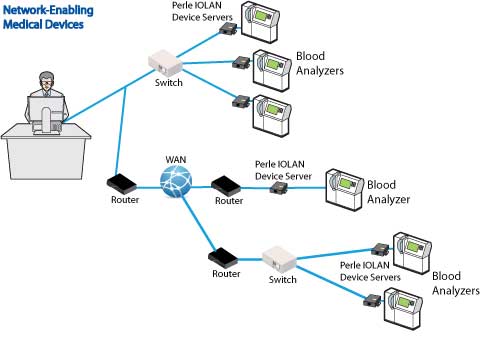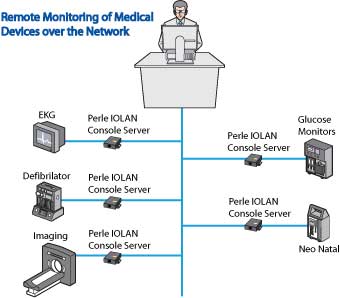The Medical Environment and the Case for Device Management
Today’s Healthcare System Faces Major Challenges
The innovative use of information technology can help drive the positive transformation of healthcare. This involves addressing several challenges – for instance a shortage of medical staff, constant budget restraints, administrative inefficiencies, and regulatory compliance. In addition, there are concerns about preventable errors, uneven healthcare quality, poor communication and coordination between the myriad of healthcare professionals. Healthcare spending and health insurance premiums continue to rise at rates much higher than the rate of inflation while hospitals, clinics and laboratories endeavor to increase productivity and reduce billing cycles.
IT, in the form of Healthcare Management Technology is at the top of many healthcare strategic priority lists. This is a way to overcome the challenges and accelerate the changes that will bring about an efficient next generation healthcare system. In this article we will look at four applications where device management solutions are used in various medical environments. The business case for connectivity of medical devices is strong and the operational and financial benefits are clear. These benefits include increased productivity, decreased errors, improved patient care, shorter billing cycles, and standards compliance.
Network-Enable Medical Devices
Accurate patient information is at the heart of the industry and is dependent on information sharing and technological innovation. To build upon the progress already made in the area of health information technology, data collected at the patients’ bedside, in the operating theatre or the nurses’ station needs to be stored, transmitted and monitored securely. The best way to do this is by Ethernet-enabling the medical equipment.

Device Servers allow for medical equipment with a serial port, such as blood analyzers (or any device with a RS232 connection) to be network-enabled. Results from these medical devices can then be transmitted securely over the Internet. This results in patient data being updated quickly and accurately. An antiquated paper based flip chart cannot make the same claim.
This data can be transmitted to and securely accessed from anywhere such as the nurses’ stations, laboratories, pharmacies, patients’ homes and doctors’ offices. As there is no human intervention in data transfer, there is also no room for human error. The data is transferred in real-time making diagnosis faster - potentially saving lives. In addition, billing information is never omitted or overlooked but is securely and accurately transmitted to the record systems that drive patient billing. This reduces loss of revenue for the hospital. The hospital can now extend the life of existing equipment rather than replacing it with costly medical devices that are Ethernet ready, thereby decreasing the Total Cost of Ownership (TCO) and increasing Return on Investment (ROI).
Remote Monitoring and Management of Medical Devices over the Network
Optimum safety and performance-continuity of medical devices such as laboratory equipment, X-ray machines, nuclear and medical imaging and various medical monitors is of the utmost importance for the integrity of the Healthcare system.
All involved in the life span of a medical device: the government, the manufacturer, the importer/vendor, the user and the public – each has a specific role to play in collaborating to safeguard public health by ensuring that medical devices meet appropriate standards of safety, quality and performance. This is accomplished by linking to networks that monitor medical devices and participating in post-market surveillance and medical device alert issues.
Console Servers allow equipment to be constantly monitored over the network, alerting the appropriate personnel if the equipment is performing outside normal operating parameters – thereby pre-empting maintenance. With this type of preventative maintenance, service calls are often unnecessary. When an on-site service call is required, the service technician already knows what the problem is, what replacement part is needed and what human resources are required so that repairs are completed much more quickly and crucial medical equipment downtime is shortened significantly. In a critical industry such as healthcare, remote monitoring not only saves equipment downtime costs, but saves lives.

Access to the console management ports of medical equipment must be restricted to authorized personnel only. To ensure this, strong authentication schemes such as TACACS+, RADIUS and SecureID are used to centrally authenticate and authorize user access and usage. It important therefore to choose a console server solution that provides full support for these standard schemes.
Data Collection and the EMR
Perhaps the biggest driver to medical device connectivity at the Point of Care (POC) is the electronic medical record. By connecting medical equipment directly to the network, data can be securely transmitted to the Electronic Medical Record (EMR). Some hospitals continue to rely on their nursing staff to transcribe data from electronic devices to the electronic record. This is a waste of a nurse’s precious time – time better spent on patient care or monitoring. Some reports have shown a 4.4% error rate when manually transcribing vital signs into an electronic medical record.
There is also a detriment to quality care due to transcription errors and delays getting updated device data to decision makers. The healthcare industry of today is a ‘mobile’ one with healthcare professionals practicing in numerous clinics, while critical information is being sent instantaneously to homes, laboratories and even across the globe.
Health care providers that store patient data electronically or transmit health care information electronically are under pressure from the Department of Health and Human Services (D.H.H.S) to comply with all HIPAA standards. These regulations have a number of implementing effects that set a high standard for the health care provider, specifically in regard to the security of digital networks that are increasingly used to transmit patient data. More and more of the medical world's business relies on digital communication systems. Those networks contain the stored information available for transmissions that are open to security weaknesses. Past practices in managing network infrastructure are no longer acceptable. Security of the healthcare networks used to transmit and access the medical data is increasingly important and needs a secure and reliable network management technology. When selecting equipment that transports private patient records, ensure that support for strong authentication schemes and data encryption such as AES is available.
Final Thoughts
In this article we have looked at four applications where serial to Ethernet connectivity solutions have been used to network-enable various medical devices. Clearly, the increased productivity, decreased errors, improved patient care, protocol compliance and shorter billing cycles make for a strong business case for Ethernet enabling medical devices.
The operational and clinical benefits of Ethernet-enabling medical devices are emphasized and therefore practitioners and hospital staff usually encourage these technological advances. Such broad acceptance of adoption among healthcare workers eases implementation and helps ensure success.
A Wise Choice
Selecting the best solution for device management in a medical environment is clear when considering a solution from Perle Systems.
For a cost-effective serial-to-Ethernet solution that maintains serial device protocol integrity across Ethernet, a Perle IOLAN STS, SDS or SCS model is your best choice. Having the highest performance processor available along with Perle’s unique TrueSerial™ technology, the IOLAN will provide the most authentic serial connections across Ethernet ensuring reliable and secure transmission of medical data across the network.
About Perle Systems
Perle Systems offers the most secure and reliable connectivity solutions for a wide range of applications and businesses including many medical device connectivity scenarios.
Perle Systems has over 30 years of experience delivering the quality and dependability to support critical systems.
We offer a Lifetime Warranty on most of our products and a commitment to continue developing feature-rich products that offer flexibility, performance, competitive pricing and ease of implementation.